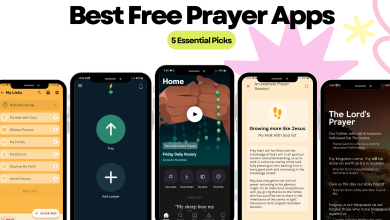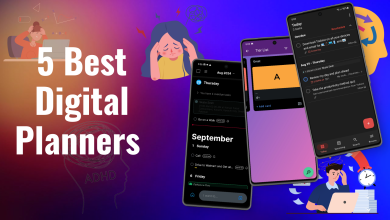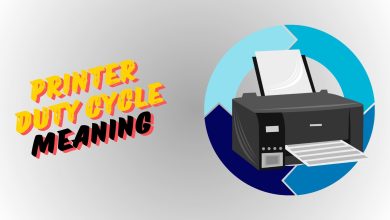Soundbar vs. Speakers: Which is the Best Audio System?
- Soundbars are affordable, easy to set up, and compact, making them suitable for smaller spaces and casual viewers.
- Speakers provide a high-quality, immersive audio experience but are more expensive, require more space, and involve complex setup.
- Choosing between soundbars and speakers depends on your budget, space, and preference for either convenience or superior sound quality.
The built-in speaker output for modern TVs is barely ever enough to deliver an immersive, high-quality audio experience. This is when most people decide to upgrade their TVs’ sound performance profile with external hardware and are met with two difficult choices — soundbars and speakers.
This article will have all you need to know to make an informed decision, choosing between the two, addressing their convenience, use-case, preferred sound profiles, and budgetary constraints. It’ll also mention some of the better options under a specific budget for each of the two options.
Table of Contents
How Does Sound Work?
The acoustic phenomenon within each pair of headphones, speakers, or soundbars is more or less the same. No matter the device in use, sound will reach your ears in the form of mechanical vibrations through a medium, which—in most cases—is the air gap between your ears and the source. The way any speaker achieves this is beyond the scope of this guide, but know that—on the very basic scale—they work by transforming amplified electrical waves from the playback device to sound pressure waves for you to hear in real life.

While the primary purpose of every speaker, be it an earphone, soundbar, or loudspeaker, is more or less the same, the differences arise in how they produce sound, each with a different type of driver. A “driver” is essentially the main muscle of a speaker, where it pushes and pulls the sound (in the most basic sense) to produce sound vibrations. Here, you have different kinds of drivers—subwoofer, woofer, mid-range, and tweeter.
READ MORE: Multi-Channel Home Theater: Everything You Need to Know ➜
What is a Soundbar?
A soundbar is an array of speakers housed in a single enclosure, often with another type of built-in driver, mainly subwoofers and tweeters. In the most traditional sense, soundbars are more horizontal in dimensions than they are vertical, which allows them to be placed below or in front of a TV screen.

↪ Pros & Cons
Soundbars are often synonymous with convenience and affordability, but their form factor is what gives them unique benefits, and drawbacks, when compared to the traditional speaker system.
Advantages:
- Better than Built-In Speakers: Soundbars often sound better than most built-in TV speakers. They provide a richer sound base and are often preferred for their ability to deliver clear dialogue.
- Affordable: The soundbar form factor, in general, doesn’t cost as much as a full-fledged speaker system, which means it can deliver a much better experience than the built-in audio without breaking the bank.
- Easy to Set Up: A soundbar is usually not hard to set up. Often times, it simply needs a few cables to connect to your TV, and the device itself could be placed on a table or mounted below a TV.
- Portable: Since most soundbars don’t require a bunch of cables or complex wiring connections to connect to your TV, they can easily be disconnected and moved to a different location. A normal soundbar weighs less than a few kilograms, which is why it is easier to move around, too.
- Compact: The soundbar doesn’t take up a lot of space around your TV, meaning it provides a much cleaner look overall and delivers better audio in a small, compact setup.
Disadvantages:
- Upgrade Limitations: Unlike a modular home theatre speaker system, soundbar have less options when it comes to upgrading individual components.
- Lack of Soundstage: Since a soundbar has a limited area to where the sound is actually produced, it can struggle to replicate a truly immersive surround sound, even when most support Dolby Atmos and DTS surround technology.
- Limited Bass Profile: Most soundbars, even those with a dedicated subwoofer, usually show a drop-off at the lower frequencies when compared to a full speaker system. They may not be as immersive and may fail to produce a deep, strong bass.
↪ Who Should Buy It?
While soundbars may be placed below a home theater setup the list of devices that deliver the best sound experiences, they are suitable and practical for a particular niche of people. This includes users who are just starting out on bringing upgrades to their personal audio systems for their TVs or studios and prefer starting out slow without spending too much.

Since a soundbar doesn’t offer a lot of modularity and is catered to the general audience, it is easy to fine-tune your preferred sound profile. This form factor is generally suited to people with limited space, specifically smaller living rooms or apartments.
For users who are casual watchers and music listeners, a soundbar may strike the perfect balance in audio quality and dialogue clarity. Many speaker systems find it hard to produce clear dialogue, which can be frustrating when watching movies, listening to news, or watching sports.
READ MORE: How to Fix iPhone Speakers Not Working ➜
Speakers and the Surround-Sound System
Unlike soundbars, speaker systems are more widely understood and known. Most home theater setups include multiple speakers that can be placed or installed around the entire listening space, providing a “true” immersive experience, similar to a real theater. Most sound systems come with a dedicated subwoofer that accurately reproduces low frequencies, delivering a more authentic soundstage.
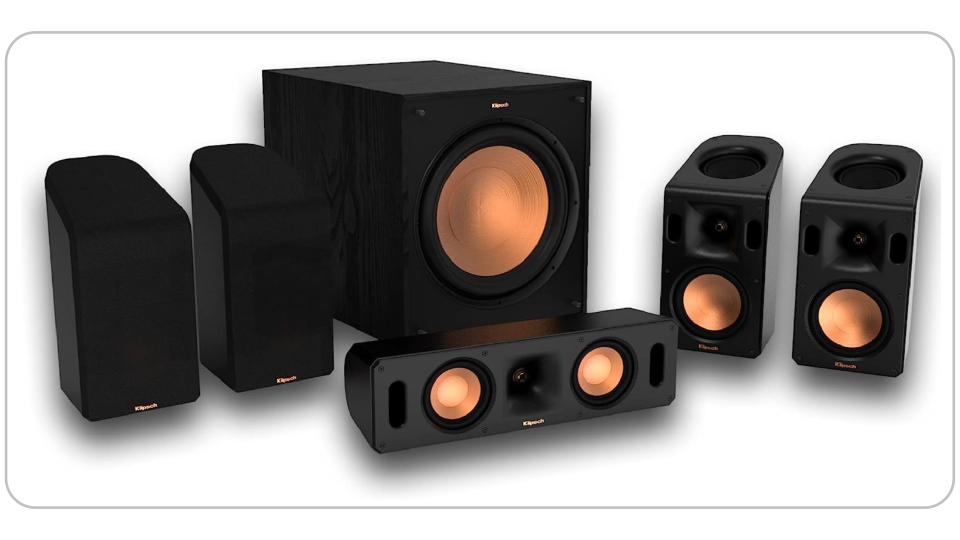
↪ Pros & Cons
A full-fledged speaker system produces a high-fidelity, richer acoustic environment, creating a cinematic soundstage. However, it comes at a hefty cost, the wires are a nuisance to deal with, and is heavily influenced by spatial considerations.
Advantages:
- Accurate Sound Reproduction: A surround sound system will create an enveloping soundstage, where the audio reproduction is accurate enough to make you feel like you’re in the middle of the action on-screen.
- High-Quality Audio: With speakers actually ‘surrounding’ the sound-space, the surround system produces lifelike audio. Keep in mind though that the content/service you’re watching should support the number of speakers in-use. For instance, a service that only supports the 2.1 audio channel would leave all speakers, other than the main two, silent.
- Flexible Upgrade Path: Speaker systems can generally be paired with multiple manufacturers and ‘modules.’ You can use a differently branded subwoofer from, say, the main speaker system, which allows you to fine-tune your experience on a more audiophile level.
- The ‘Theatre’ Experience: If the content on-screen supports the appropriate number of audio channels, the surround speaker system can deliver a theater-like experience, which any soundbar will fail to match.
Disadvantages:
- Cost: Most home theatre setups come in almost north of $1,000, and go up as much as is possible with a very narrow end. This is why this sort of setup isn’t recommended for people just starting out on TV audio upgrades.
- Limited Support: Normal cable TV broadcasts in stereo, 2.0-channel audio formats, and most services and content still don’t fully support higher audio channels.
- Wiring Clutter: A home theatre speaker system can have a lot of wires, and cable management then becomes an added nuisance on top of setting up the system itself.
- Takes up Lots of Space: A surround system with high audio channel support, like 5.1, 7.1, or even 9.1 audio, is meant to have speakers mounted or installed throughout the sound space, which is difficult to do for users with a small space.
READ MORE: How to Configure and Test 5.1 Surround Sound on Windows ➜
↪ Who Should Buy It?
The speaker setup is mostly suited to users who are heavily sensitive to audio quality or are enthusiasts. It is also recommended that people with ample space try a surround setup for a better sound experience, though it can warrant a huge investment.
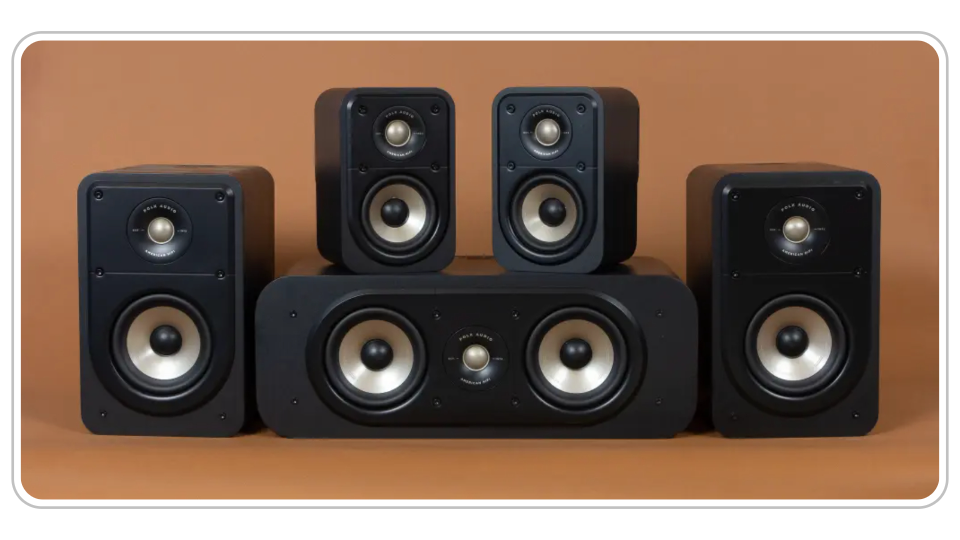
Future-proofing and upgradability are other reasons to look towards a full-fledged speaker setup, though it isn’t necessary that you’d want that unless concerned about an immersive and accurate soundstage, upgrading the individual components one after the other.
READ MORE: The 5 Best Ceiling Speakers to Buy in 2024 [All Budgets] ➜
The Acoustic Phenomena
Before buying any of the two sound systems above, it is important to understand certain acoustic phenomena to maximize the effect of better-sounding speakers (yes, soundbars are also speakers). Sound bounces off walls, and a larger room, with little to no furniture, may not provide the best sound experience, even when using a more expensive speaker setup.
Enthusiasts often rely on sound-dampening materials on walls, ceilings, and floors to dampen the echo effect. Each room has a ‘dominant tone,’ where some sound frequencies sound softer than they should be and some louder than they’re meant to be.
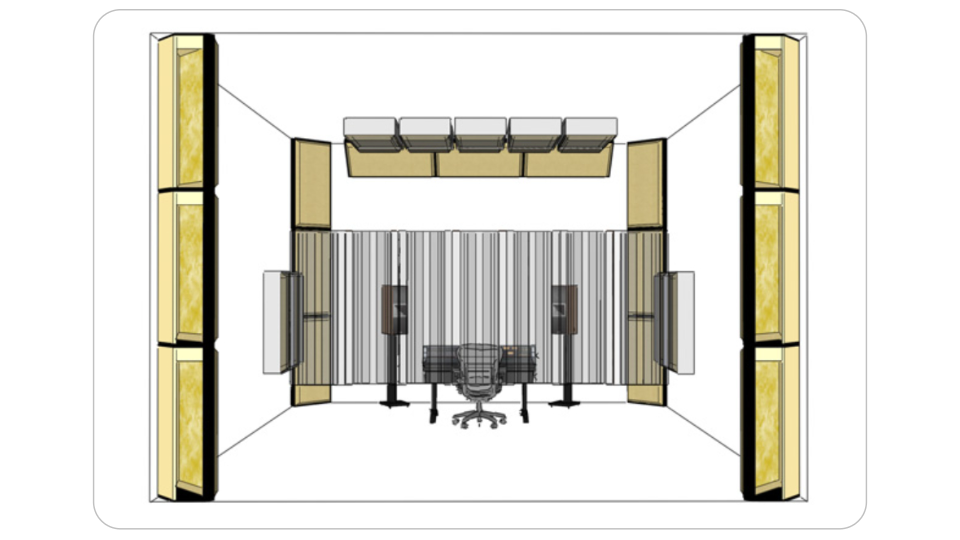
For this reason, it is recommended to properly understand your room’s acoustics and install dedicated bass traps, absorption mechanisms, and diffusers. All of this can improve the “sound image” of the room once you’re done with the upgrades and provide a relatively better level of immersion than an untreated room.
READ MORE: Center Channel Speakers – Everything You Need To Know Before Buying Them ➜
Which One Should You Choose?
With any external acoustic setup, the primary benefit is that it’s separate from the TV itself in that you can swap them out and fine-tune the sound profile to your liking. However, within each of the two, there are considerable differences that the user must address according to their preferences.
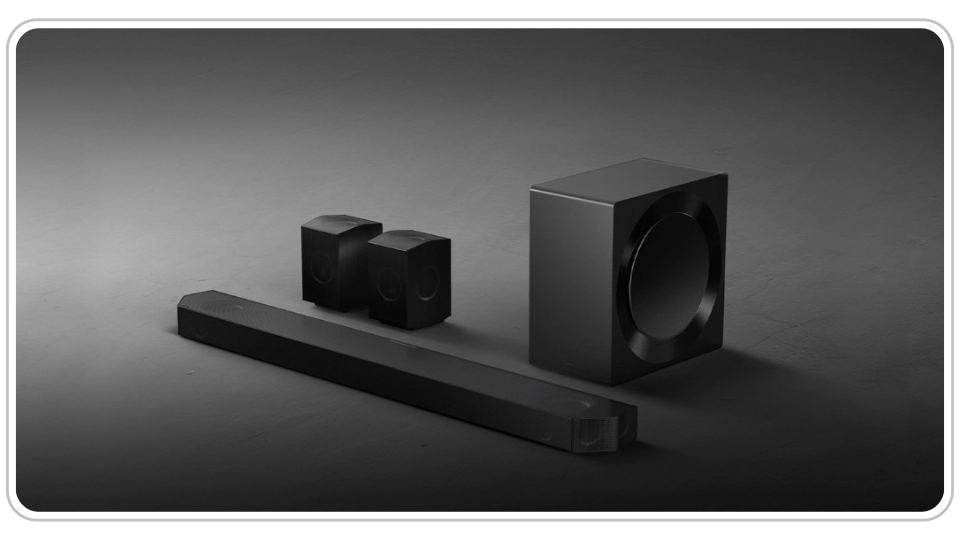
In the end, it boils down to your priorities, budget, and living space. If you want a simple setup in a more compact space and have little to no understanding of how sound works, a soundbar is the perfect choice for you. At a decent cost, it would be a huge step up from your TV’s built-in speakers.
On the other hand, if you’re on the lookout for the ‘ultimate’ sound experience and are ready to make a large investment, the surround speaker system is your choice. It does require a lot of time and effort to set up and manage the wiring, but once it’s done, it’ll sound much better than most soundbars.
READ MORE: How to Output Audio to Multiple Devices in Windows ➜
The Best Soundbar and Surround-Sound Speakers
If you’re on the lookout for quality options, we have detailed guides addressing the best speaker setups in a specific budget. It has information on the best ceiling speakers, alongside the best budget setups for your workspace.
Here are some of our picks for 2024, but keep in mind that with a diverse array of options to choose from, you’re free to look out for options that suit your specific needs and requirements.
1) Polk MagniFi Mini AX
The Polk MagniFi Mini AX is barely a bar, with its shorter length. But don’t let that fool you; it delivers massively better sound for its size. While it costs $470, the soundbar has plenty of wireless streaming options and boasts a strong sub setup with powerful bass output.
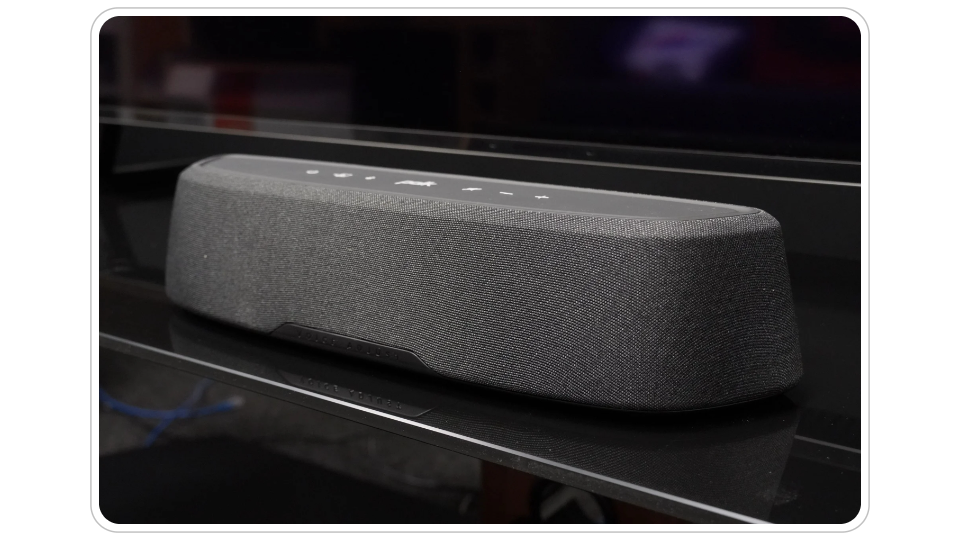
2) Hisense HS2100
In the budget soundbars, the Hisense HS2100 is a decent option around the $100 mark. It can be a huge step up from your TV’s built-in speakers but lacks the bells and whistles of its more expensive counterparts. Reviewers have found compression artifacts at higher volumes, which may not be ideal for a decent sound experience.

3) ELAC Debut 2.0 B6.2
This pair of bookshelf speakers can be matched with any home theatre setup for clear sound and sturdy build quality. The pair provides a better-defined soundstage with a warmer tonal balance. All in all, the sound feels comfortable and easy to listen to. The ELAC Debut 2.0 B6.2 can be found for $400 on Amazon at the time of this writing.
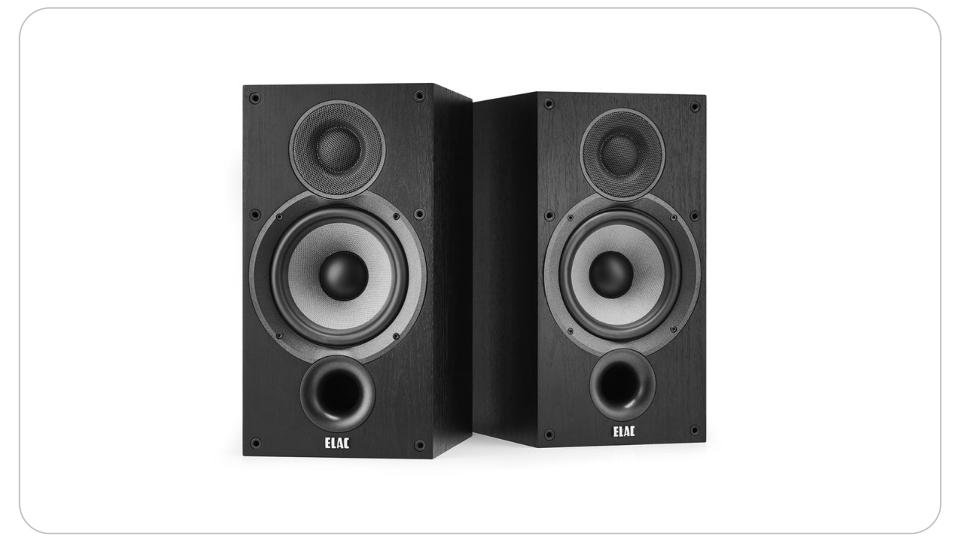
READ MORE: 5 Best Computer Speakers Under $50 ➜
Conclusion
The speaker versus soundbar debate is one for the user in question to decide. In the end, the best way to choose between the two is to listen to both of the systems separately and judge for yourself. Any guide or video on the internet may not be able to fully explain in words the sound environment for both of the systems in real life.
FAQs
While the price for the two is variable, a decent soundbar can start at ~$200-$300, while a surround sound system can touch the lower end of four digits for a decent system.
Yes, it can. A soundbar can use virtual surround sound technology, but given its limited space, there’s only so much surround that you’ll hear.
The aesthetics for each of the two depends upon the user’s space. But generally, soundbars are smaller and have a sleeker, minimalist design than full-fledged speaker systems.
